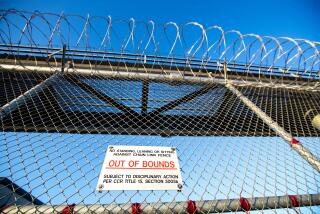U.S. Sikhs say military’s ban on long hair and beards keeps them out
- Share via
WASHINGTON — Raised on his father’s and grandfather’s tales of military service in India, Amitoj Chhabra wanted nothing more than to follow in their footsteps and join the U.S. Air Force.
“I dreamt it. I slept it. It was all I ever thought about 24/7,” Chhabra recalled.
But the dream died before he even reached boot camp.
When he tried to enlist, Chhabra, a Sikh from Reno, was told that his long hair and beard, which Sikhs are religiously mandated to keep unshorn, collided with Air Force grooming requirements. He requested a religious waiver, but after two months, he received no response. Next he tried the Army, but says his application was rejected.
Now numbering more than 500,000, Sikhs living in the U.S. say Pentagon policies regulating soldiers’ grooming and appearance have resulted in a de facto ban against Sikhs joining the military, forcing them to choose between practicing their religion and serving their country.
Of the more than 500,000 active-duty troops in the Army, only two are Sikhs. A third serves in the reserves.
Though the Defense Department in January issued new guidelines on granting religious exemptions for Sikhs and others, Sikhs complain the new policy only made matters worse because it could require a Sikh to cut off his hair and beard while awaiting a response to his request for a religious exemption.
Even if granted, he would then have to reapply for an exemption before every new assignment — always with the possibility of being asked to cut his hair and beard.
For practicing Sikhs, that’s not an option.
“I would gladly sacrifice my life for the mission,” said Maj. Kamaljeet Singh Kalsi, who in 2009 became the first Sikh to be admitted into the Army in decades. “But I could not cut my hair and remove my turban. They’re not mine to give. They belong to my God.”
Sikh activists are prodding the White House and Pentagon to do more to allow Sikhs to serve. The effort gained the backing of more than 100 House members and the Indian ambassador to the U.S., Subrahmanyam Jaishankar, as well as several religious liberty and faith groups, including the American Civil Liberties Union and the American Jewish Committee.
The military’s grooming policies “are an integral part of unit cohesion, good order and discipline and, ultimately, mission accomplishment,” said Alayne Conway, an Army spokeswoman. In the Army, recruits must wear “neat and conservative” hairstyles, with a “tapered” cut and a clean-shaven face. Mustaches are allowed.
U.S. courts have affirmed the military’s right to place unit cohesion and morale over the rights of recruits to express their religion. In 1986, the Supreme Court sided with the Air Force in a suit brought by an Orthodox Jew who was ordered not to wear a yarmulke under his service cap. Congress later passed a law allowing the practice.
Kalsi, 37, who is now serving in a Ft. Knox reserve unit, was allowed to keep his hair and beard during his service.
He kept his beard knotted to allow space to fasten his gas mask and wore a special camouflaged “diamond-shaped turban” crafted from Army uniform material. “It took a little maneuvering,” he said.
He completed boot camp and eventually earned a Bronze Star for his service in Afghanistan. His different appearance sometimes proved to be an advantage, he said, recalling a time inside a doctor’s tent in Afghanistan’s Helmand province when locals “felt a little more comfortable around me.... Maybe it was the turban and beard.”
“If we can get to boot camp and wear the helmet, get a good feel with the gas mask and do whatever we need to be a good soldier, then we should be able to serve,” he said, adding that the current policy amounts to “employment discrimination.”
In an effort to accommodate Sikhs, the Pentagon in 2009 began offering religious exemptions to the guidelines on haircut and beards, opening the door for the three Sikhs who have joined since then.
But they were not the first. Records show that Sikhs served in the Army as far back as World War I. During Vietnam, grooming policies were relaxed to encourage more enlistment, but the Army reversed course in 1984, doing away with the long-standing exemption for Sikhs.
Rajdeep Singh, the director of law and policy at the Sikh Coalition, a nonprofit that defends the civil rights of Sikhs in the United States, said his group had been approached by 20 Sikhs who tried and failed to join the armed forces since 2011 because they worried they might have to cut their hair and beard.
“Taking away our Sikh uniform would in fact be a travesty, because it disconnects us from those same principles that make us great soldiers,” Singh said.
The turban, hair and beard date from the 17th century, when the last living Sikh Guru, Gobind Singh, decided that followers should allow their hair to grow as a sign of respect for God, known as Kesh.
For Harpreet Singh, 31, of St. Louis, who moved from India in 2009 to pursue an MBA at the New York Institute of Technology, enlisting was a way to prove his commitment to becoming a U.S. citizen.
But when he arrived on the bus to Ft. Jackson, S.C., for training, Singh said his appearance quickly made him a target for harassment. A drill sergeant mocked his turban and pulled him aside, assuming he was a translator, not a soldier. Another sergeant pressured him to cut his hair and shave his beard, saying he should make “sacrifices” to join the Army.
“They told me in books … that this country was born for freedom,’’ he said. “In practice those things are for books only.”
After the Army ultimately rejected his request for a religious exemption, Singh said he left before ever making it into boot camp.
More to Read
Sign up for Essential California
The most important California stories and recommendations in your inbox every morning.
You may occasionally receive promotional content from the Los Angeles Times.










